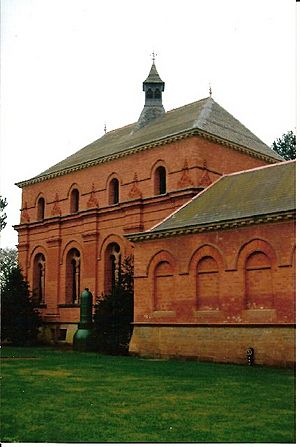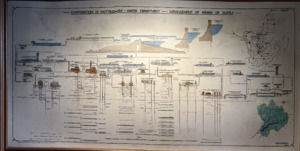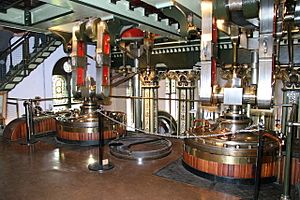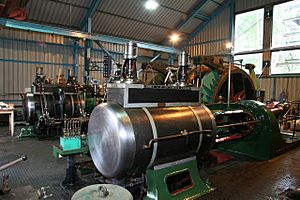Papplewick Pumping Station facts for kids
Quick facts for kids Papplewick Pumping Station |
|
|---|---|

The engine house
|
|
| Type | Water supply pumping station |
| Location | Papplewick |
| OS grid reference | SK 58274 52136 |
| Area | Nottinghamshire |
| Built | 1881 |
| Architect | Marriott Ogle Tarbotton |
| Architectural style(s) | Gothic Revival |
| Governing body | Papplewick Pumping Station Trust |
|
Listed Building – Grade II*
|
|
| Official name: Engine House, Boiler House and Workshop at Papplewick Pumping Station | |
| Designated | 18 October 1971 |
| Reference no. | 1265301 |
| Lua error in Module:Location_map at line 420: attempt to index field 'wikibase' (a nil value). | |
Papplewick Pumping Station is a historic site in Nottinghamshire, England. It was built between 1881 and 1884 to pump clean drinking water to the city of Nottingham. The station used two huge steam-powered engines, called beam engines, which were housed in beautiful buildings designed in the Gothic Revival style.
These amazing machines worked until 1969. After that, electric pumps took over the job. In 1974, a special group called the Papplewick Pumping Station Trust was formed. Their goal was to save the station and turn it into a museum. They worked hard to fix up the old engines. Now, both beam engines are working again and are started up several times a year for visitors to see. The site also has other old engines that are shown on these special "steaming days."
Contents
Why Nottingham Needed Water
In the early 1800s, getting clean water was a big challenge for cities. A man named Thomas Hawksley, born near Nottingham in 1807, became a pioneer in public water systems. He designed a system where water was always under pressure. This meant people could get water from their taps at any time, which was a new idea back then.
By the 1850s, people understood that dirty water could spread diseases like cholera and typhoid. So, there was a big need for clean, filtered water. Nottingham started building new pumping stations and reservoirs further and further north of the city. This was to find cleaner water sources. Papplewick Pumping Station was one of the last and most important of these projects. It was built in an area where the ground is made of Bunter sandstone, which naturally filters the water.
Building the Pumping Station
The Nottingham Corporation, which was like the city council, took over the water company in 1879. They asked Marriott Ogle Tarbotton to be the engineer for their gas and water systems. Tarbotton's first big task was to get more water for the city.
He decided to dig two deep wells at Papplewick. He then designed a very fancy building to hold two massive beam engines. These engines were made by a famous company called James Watt & Co. The engines got their power from steam, which came from six large boilers. These boilers were special because they had extra tubes inside to make them work better.
The first two boilers were put in place in 1881. They were used to power the machines that dug the test well. Once Tarbotton was sure there was enough water, the other four boilers were ordered and installed in 1883. Normally, three boilers would be working at a time, while the other three were resting.
Each boiler was about 29 feet (8.8 meters) long and 7 feet (2.1 meters) wide. They were covered in bricks to keep the heat in. Each boiler had two fire boxes and held a lot of water. The steam they produced powered the huge engines. Each engine had a flywheel that was 20 feet (6.1 meters) across and weighed 24 tons! The long beams of the engines weighed 13 tons each. These engines pulled water up from the wells, which were 200 feet (61 meters) deep. They could pump about 1.5 million gallons (6.8 million liters) of water every day.
To cool the engines, water was taken from a beautiful cooling pond in front of the engine house. This pond had fancy edges, a fountain, and was surrounded by gardens. The buildings themselves are very special. They are listed as Grade II* historic structures and are built in the Gothic Revival style. Inside the main engine house, you can see amazing cast iron decorations and stained glass windows. The total cost to build the station was about £55,000, which was a huge amount of money back then.
The water pumped from the wells was sent uphill to a large covered reservoir that was built in 1880. This reservoir was a huge brick structure. However, a crack was found in one of its walls in 1906, possibly from mining nearby. After that, the reservoir was no longer used. A new covered reservoir was built in 1956. The original pumps worked until 1969, when modern electric pumps took over.
Saving and Restoring the Station
When the pumping station stopped being used, people worried it might fall apart. So, in 1974, the Papplewick Pumping Station Trust was created. They worked with Nottingham City Council to lease the site and open it as a museum.
Volunteers started working to maintain the station. Soon, they had the idea to get the engines working again! Another group, the Papplewick Association, was formed to help operate the machinery. In 1975, one boiler was made safe to use. The cooling pond, which was dry, had to be cleaned out and refilled. After some adjustments, steam was raised, and one of the engines was successfully started on September 21, 1975. The second engine was fixed up and made operational later.
Papplewick Pumping Station is special because it's the only complete pumping station in the Midlands that has been fully restored and is still in working order. It was officially reopened on June 8, 2005, by The Duke of Gloucester.
The Museum Today
The pumping station is now open to the public as a museum. The Trust and Association work together to run it. They are registered with official bodies to ensure high standards for visitors.
The museum first opened its doors to the public on April 15, 1976. New visitor facilities, like a cafe and toilets, were built starting in 1991. In 2002, the Trust received a large grant of £1.6 million from the Heritage Lottery Fund. This money helped them do even more restoration work on the buildings. The quality of the restoration was so good that it won an award in 2006!
Besides the original beam engines, the museum now has several other historic engines. One is a winding engine from a nearby coal mine called Linby Colliery. It was built in 1922 and used to lift miners and coal. It was rebuilt at the museum and is now the only working steam-powered winding engine in Britain!
Another engine is a large triple expansion engine from 1897. It used to provide power at a factory. Volunteers carefully took it apart in 1979 and put it back together at the museum. It was steamed for the first time in its new home in 1998. The museum also has two engines from the Player's Tobacco Factory, which have been put together but are not yet working. There's also a single-cylinder oil engine that used to power the lights at a cinema.
The beautiful grounds around the pumping station are also recognized as a historic park and garden.
See also
- Bestwood Pumping Station
- Boughton Pumping Station
- Mill Meece Pumping Station
- Crossness Pumping Station




